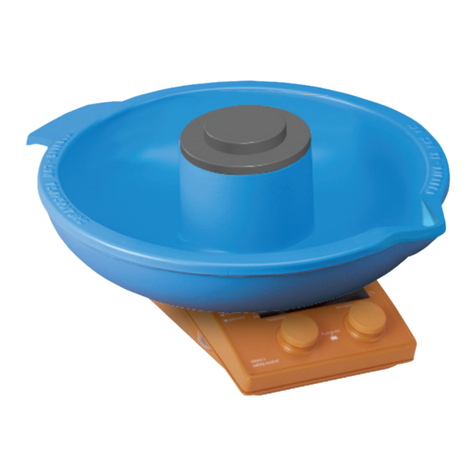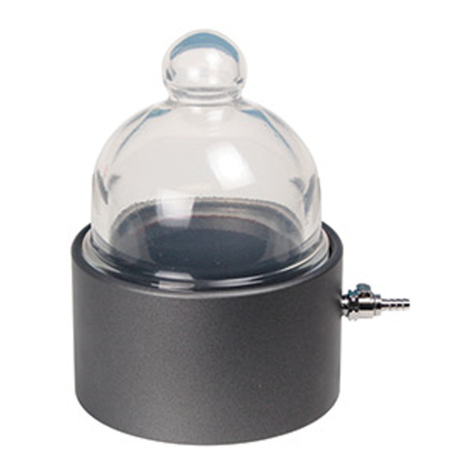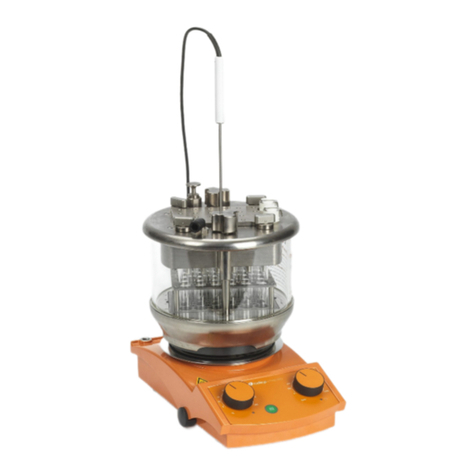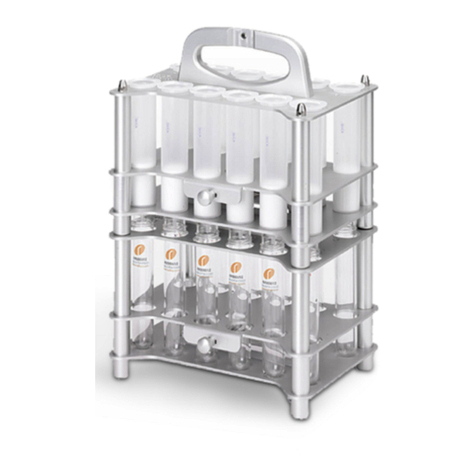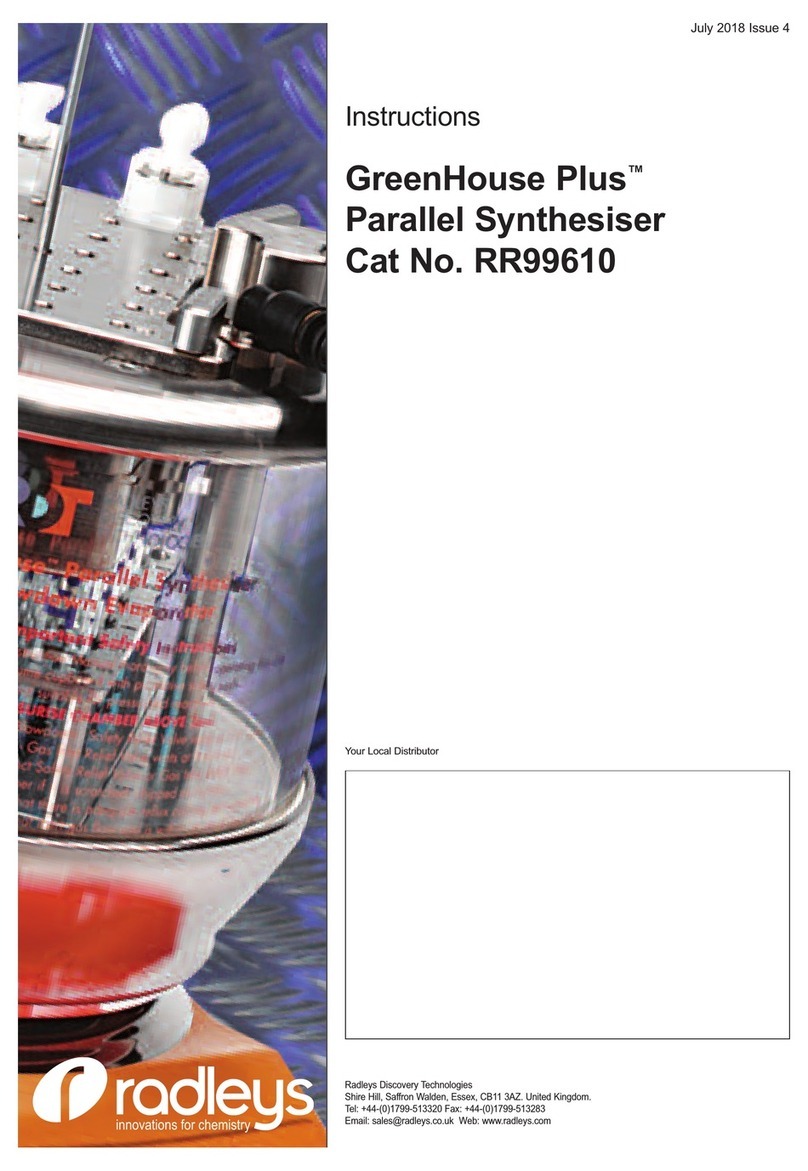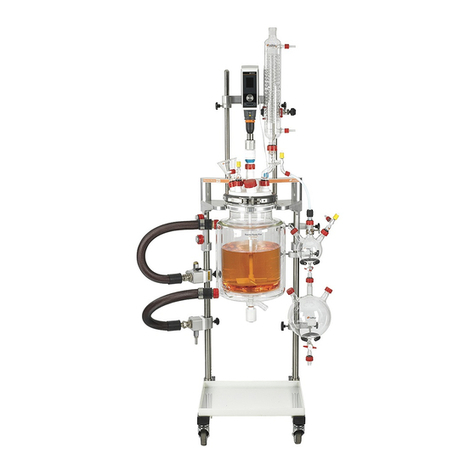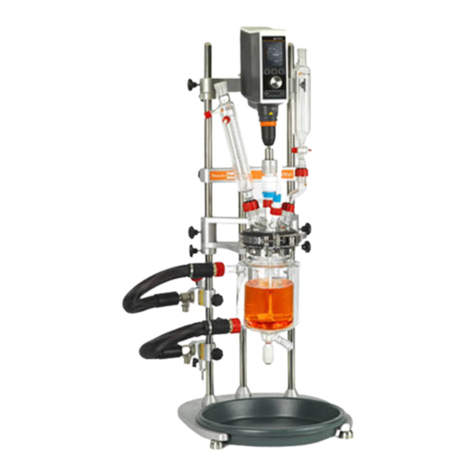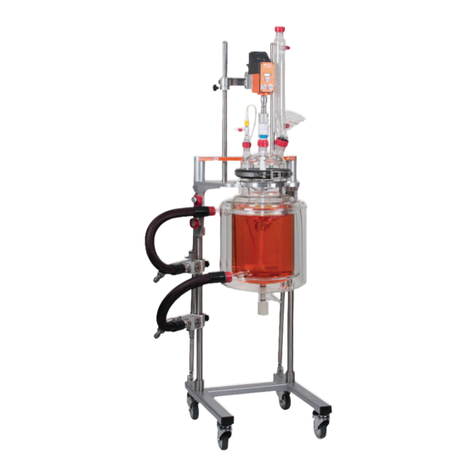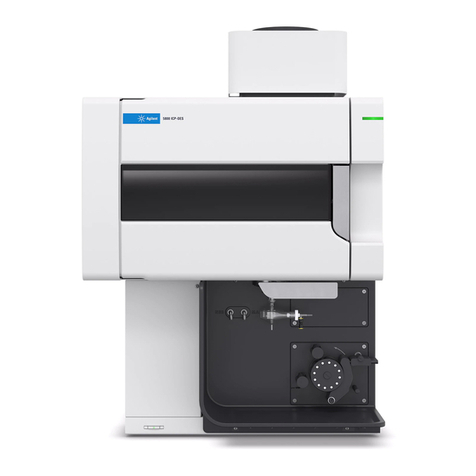Page 4
Reactor-Ready - Lab Reactor
5. Products & Accessories
How to order Reactor-Ready…
1. Select the Reactor-Ready Core: RR121000
2. Select the vessel size and whether you want single or double/vacuum
jacketed, then select the Vessel Kit you need
3. Select your overhead stirrer
4. If you need a thermoregulator/circulator, hoses, hose adapters, thermofluid
or accessory glassware like condensers or dropping funnels, then select
from the accessory list overleaf
5. Place your Purchase Order
Reactor-Ready Core System
RR121000 Reactor-Ready Core System. Includes:
•Stand with base, drip tray, support rods, bosses and all clamps
•Vessel to framework insulated hoses with quick-release connections
•Upper & lower drain-down manifolds
•PTFE Stirrer guide and coupling
•Glass reaction vessel lid with sealing caps
•Vessel FEP o-ring seal and PTFE centering collar
•Two stainless steel vessel support collars
Important: Hoses to connect the Reactor-Ready framework to your thermoregulator are
NO included. You will require hoses with a M24 connection or appropriate adapters.
See accessory list below for hoses, adapters and suitable thermoregulators.
Reaction Vessel Kits
These cost effective kits include all you need to get started; glass reaction vessel,
PTFE anchor stirrer paddle, PTFE PT100 temp probe (with Lemo plug for connection
to thermoregulator) and PTFE temperature probe adapter.
RR120010 250ml Single acketed Vessel Kit
RR120015 250ml Vacuum acketed Vessel Kit
RR120020 500ml Single acketed Vessel Kit
RR120025 500ml Vacuum acketed Vessel Kit
RR120030 1000ml Single acketed Vessel Kit
RR120035 1000ml Vacuum acketed Vessel Kit
RR120040 2000ml Single acketed Vessel Kit
RR120045 2000ml Vacuum acketed Vessel Kit
RR120050 5000ml Single acketed Vessel Kit
RR120055 5000ml Vacuum acketed Vessel Kit
Overhead Stirrers
501-20200-00 Heidolph Stirrer RZR 2020
501-20410-00 Heidolph Stirrer RZR 2041
501-20521-00 Heidolph Stirrer RZR 2052 Control
Thermoregulators, Hoses, Adapters & Thermofluids…
Important: For technical advice on selecting the thermoregulator, thermofluid or hoses
for your application please contact our technical sales team on el: +44(0)1799-513320
or E-mail: sales@radleys.co.uk
Huber Thermoregulators/Circulators
HB201501.04 Ministat 230-CC
HB103001.04 Petite Fleur
HB100001.05 Unistat Tango
HB100203.05 Unistat 405
HB100102.05 Unistat 705
Thermoregulator Hoses & Adapters
HB9274 M24x1.5 Insulated Hose NW12 100cm
HB9275 M24x1.5 Insulated Hose NW12 150cm
HB9276 M24x1.5 Insulated Hose NW12 200cm
HB9277 M24x1.5 Insulated Hose NW12 300cm
HB6724 M24x1.5 Female to M16x1 Male Adapter
HB6945 M24x1.5 Male to M16x1 Female Adapter
HB6723 M24x1.5 Female to M30x1.5 Male Adapter
HB6195 M16x1 90 degree Adapter
HB9256 M24x1.5 90 degree Adapter
HB6089 M16x1 Nut
HB12634 M24x1.5 Nut
HB6086 M16x1 Hose Connector NW8
HB9471 M24x1.5 Hose Connector NW12
HB6091 M16x1 Isolating Ball Valve
HB9236 M24x1 Isolating Ball Valve
Thermofluid
HB6159 SynOil M10.155.08, 5 Litre Range -10 to +155°C
HB6160 SynOil M10.155.08, 10 Litre Range -10 to +155°C
HB6161 SilOil M20.235.20, 5 Litre Range -20 to +235°C
HB6162 SilOil M20.235.20, 10 Litre Range -20 to +235°C
HB6163 SilOil M40.165.10, 5 Litre Range -40 to +165°C
HB6164 SilOil M40.165.10, 10 Litre Range -40 to +165°C
HB6165 SilOil M60.115.05, 5 Litre Range -60 to +115°C
HB6166 SilOil M60.115.05, 10 Litre Range -60 to +115°C
HB6479 DW-Therm M90.200.02, 10 Litre Range -90°C to +200°C
Optional Accessories & Replacement Parts…
Reaction Vessels Only
RR130250 250ml Single acketed Vessel
RR130255 250ml Vacuum acketed Vessel
RR130500 500ml Single acketed Vessel
RR130550 500ml Vacuum acketed Vessel
RR131000 1000ml Single acketed Vessel
RR131050 1000ml Vacuum acketed Vessel
RR132000 2000ml Single acketed Vessel
RR132050 2000ml Vacuum acketed Vessel
RR135000 5000ml Single acketed Vessel
RR135050 5000ml Vacuum acketed Vessel
Reaction Vessel Lid
RR136000 5 Neck Lid - 1 x B19, 2 x B24, 1 x B29, 1 x B34
Reaction Vessel Support Collar
RR121048 Vessel Support Collar
Important: he support collar is needed for your Reactor-Ready vessel to fit in the novel
quick-release clamp. wo collars are supplied with the Reactor-Ready Core System
(RR121000), if you require more for additional vessels see details below:
PTFE Pt100 Temperature Probes & Adapters
RR140250 Probe 8mm with Lemo Plug - 250ml & 500ml vessels
RR141000 Probe 9mm with Lemo Plug - 1000ml & 2000ml vessels
RR145000 Probe 9mm with Lemo Plug - 5000ml vessel
RR140010 PTFE Temperature Probe Adapter - 8mm
RR140015 PTFE Temperature Probe Adapter - 9mm
PTFE Stirrer Shafts
RR150250 Anchor PTFE Stirrer Shaft - 250ml vessels
RR150255 Retreat Curve PTFE Stirrer Shaft - 250ml vessels
RR150260 Turbine PTFE Stirrer Shaft - 250ml vessels
RR150500 Anchor PTFE Stirrer Shaft - 500ml vessels
RR150505 Retreat Curve PTFE Stirrer Shaft - 500ml vessels
RR150510 Turbine PTFE Stirrer Shaft - 500ml vessels
RR151000 Anchor PTFE Stirrer Shaft - 1000ml vessels
RR151005 Retreat Curve PTFE Stirrer Shaft - 1000ml vessels
RR151010 Turbine PTFE Stirrer Shaft - 1000ml vessels
RR152000 Anchor PTFE Stirrer Shaft - 2000ml vessels
RR152005 Retreat Curve PTFE Stirrer Shaft - 2000ml vessels
RR152010 Turbine PTFE Stirrer Shaft - 2000ml vessels
RR155000 Anchor PTFE Stirrer Shaft - 5000ml vessels
RR155005 Retreat Curve PTFE Stirrer Shaft - 5000ml vessels
RR155010 Turbine PTFE Stirrer Shaft - 5000ml vessels
Glassware Accessories
RR139005 Condenser Liebig 250mm B29 + GL14 + fittings
RR139007 Condenser Double Surface 200mm B29 + GL14 + fittings
RR139009 Condenser acket Coil Rodaviss B29 + GL14 + fittings
RR139011 Right Angle Adapter B29 + GL14 + PTFE fittings
RR139013 50ml Graduated Dropping Funnel Equalising Arm B24
RR139015 100ml Graduated Dropping Funnel Equalising Arm B24
RR139017 250ml Graduated Dropping Funnel Equalising Arm B24
RR139019 500ml Graduated Dropping Funnel Equalising Arm B24
RR139021 1000ml Graduated Dropping Funnel Equalising Arm B24
RR139023 Swan Neck Adapter B24 to B24
RR139025 Gas Purge Adapter B24 + GL14 + fittings
RR139027 Glass Cone Stopper B19
RR139029 Glass Cone Stopper B24
RR139031 Glass Cone Stopper B29
RR139033 Glass Cone Stopper B34
RR139035 Enlarging Adapter B24 to B29
RR139037 Enlarging Adapter B29 to B34
RR139039 Reducing Adapter B24 to B19
RR139041 Reducing Adapter B29 to B19
RR139043 Reducing Adapter B29 to B24
RR139045 Reducing Adapter B34 to B19
RR139047 Reducing Adapter B34 to B24
RR139049 Reducing Adapter B34 to B29
RR139051 Oil Bubbler Type 1 B24 + GL14 + fittings
RR139053 Solid Additions Funnel B34 (with extended tube)
RR139055 Liquid Additions Tubing Adapter B24 to GL14
RR139057 Valved Liquid Inlet Adapter B24 to GL14
RR139059 Reflux Divider Head B29
RR139061 Reflux Divider Head Receiver Bend
RR139063 PTFE Hose Adapter B19 for NW12 Tubing
RR139065 PTFE Hose Adapter B24 to 15mm Bore
RR139067 Boss Head
RR139069 3-Prong Clamp
US A Length Joints: For US ‘A Length’ glass cones and sockets please add a suffix /US to
the catalogue number when placing your order


